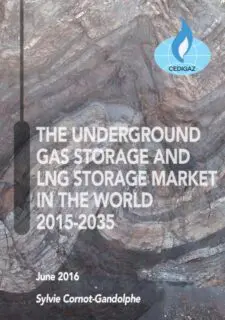UGS - Underground Gas Storage

Underground Gas Storage in the World - 2024 Status
| Non Member | 1200 € | |
| Member | FREE | Login |
In an era marked by fluctuating energy markets and geopolitical tensions, the importance of underground gas storage (UGS) has never been more pronounced. As the backbone of global gas security, UGS facilities play a critical role in balancing supply and demand, mitigating price volatility, and ensuring a stable energy supply during peak consumption periods. The recent global gas crisis has thrust UGS into the spotlight, prompting accelerated growth and renewed investment in this vital infrastructure.
By the end of 2023, the global working gas capacity of UGS reached 437 billion cubic meters (bcm), a 2% year-on-year increase—the largest since 2015. This surge is primarily due to significant capacity expansions in China, with additional contributions from Europe, Kazakhstan, and Canada. The number of operational UGS facilities globally stood at 681, with China commissioning five new facilities and Saudi Arabia adding its first. The global peak withdrawal rate also increased by 1.6% to 7,516 million cubic meters per day (mcm/d).
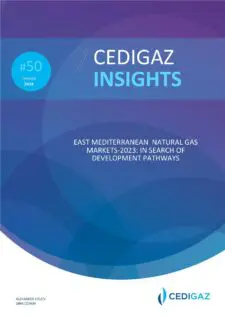
East Mediterranean Natural Gas Markets-2023: in Search of Development Pathways
| Non Member | 2000 € | |
| Member | FREE | Login |
Amidst the gas supply crisis aftermath in Europe and with global spot gas prices remaining in the double-digit range for the past years, the EastMed natural gas sector has been attracting growing attention from major producers, investors, and potential gas buyers. With vast reserves amounting to trillions of cubic meters, the EastMed countries hold the potential to bolster their own energy security and expand global gas export capabilities alleviating pressure in the tight gas market.
The latest CEDIGAZ report “East Mediterranean Natural Gas Markets-2023: in Search of Development Pathways” authored by Alexander Kislov and Gina Cohen, presents a thorough analysis of the development of the EastMed natural gas province, examining the most recent advancements in Egypt, Israel, Türkiye, Cyprus, Jordan, and Lebanon, and perspectives of new large-scale gas exports projects. While the future of the EastMed natural gas province is contingent on various factors, the detailed information and complete data presented in the report provide an opportunity to outline the potential outcomes and contours of the EastMed puzzle.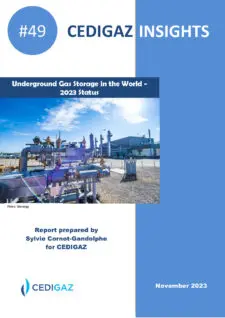
Underground Gas Storage in the World - 2023 Status
| Non Member | 990 € | |
| Member | FREE | Login |
The CEDIGAZ 2023 report highlights significant shifts in the global gas market, with a 1.3% increase in Underground Gas Storage (UGS) capacity, driven by the global gas crisis. Major contributors include China and Europe, with a focus on expanding storage in rapidly developing markets like the Middle East. The report notes a 20% growth in UGS projects in 2022, reflecting the sector's growing importance in natural gas supply security.
The global energy crisis, especially due to Russia's invasion of Ukraine, has reshaped the gas market, leading to more flexible and price-sensitive LNG trade. Governments globally are focusing more on natural gas security, introducing stricter storage regulations and strategic LNG reserves. Japan proposed an international cooperation framework to enhance LNG security.
Europe's RePowerEU plan, a response to Russian aggression, seeks to lessen reliance on Russian fossil fuels, mandating higher gas storage levels. In 2022, storage exceeded EU regulations, reaching 95% by November. Other regions, including Ukraine, the US, China, and the Middle East, are also advancing in UGS, adapting to their specific market needs.
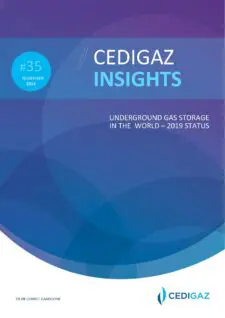
Underground Gas Storage in the World - 2019 Status
- At the end 2018, there were 662 underground gas storage (UGS) facilities in operation in the world. The global working gas capacity reached 421 bcm
- North America concentrates more than two thirds of the sites and accounts for almost 40% of global working gas capacity and half of global deliverability, the top five countries (United States, Russia, Ukraine, Canada and Germany) account for 70% of the worldwide capacities
- Storage in depleted fields dominate with 79% of global working gas volumes, but storage in salt caverns now accounts for 26% of global deliverability
- In 2018, the growth in gas storage capacity contrasted with the trends observed since 2015
- At worldwide level, there are 102 identified projects at different stages of planning
- UGS development activity is dominated by China, which alone accounts for almost half of the 37 bcm of working gas capacity under construction
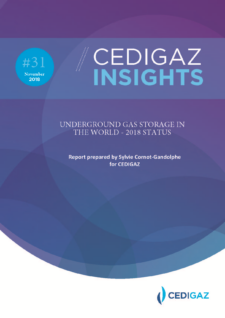
Underground Gas Storage in the World - 2018 Status
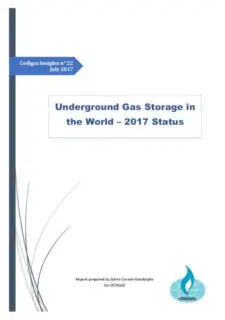
Overview of Underground Gas Storage in the World 2017–Status
